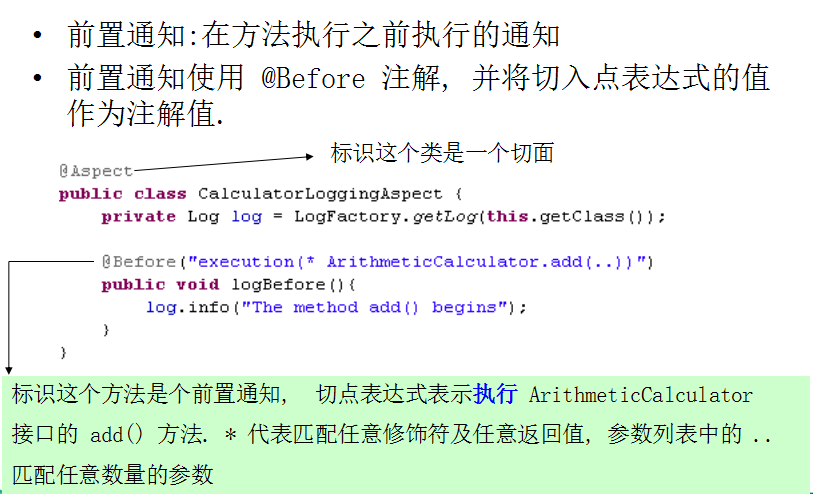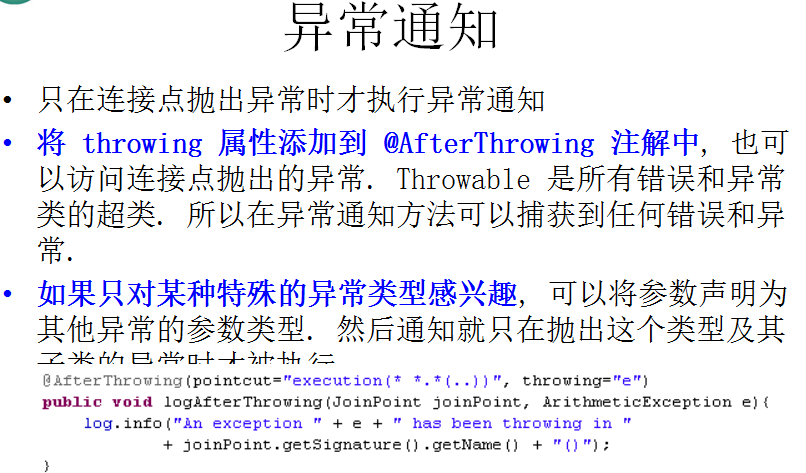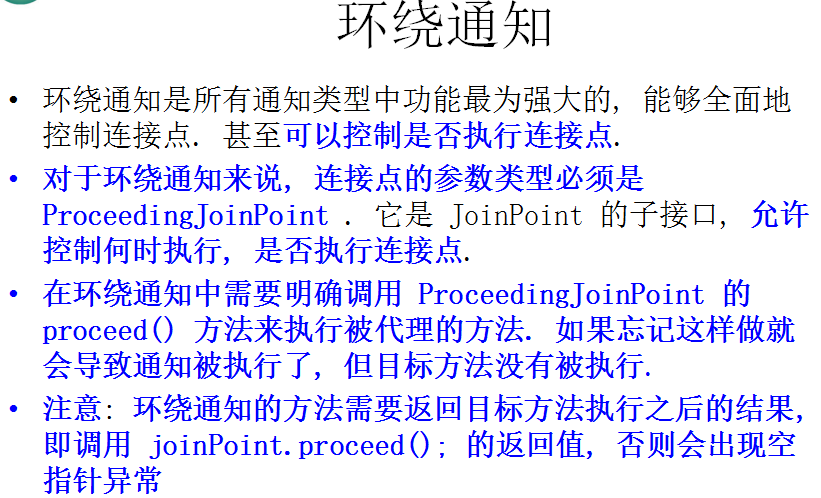joinpoint和proceedingjoinpoint对象
joinpoint对象封装了springaop中切面方法的信息,在切面方法中添加joinpoint参数,就可以获取到封装了该方法信息的joinpoint对象.proceedingjoinpoint对象是joinpoint的子接口,该对象只用在@around的切面方法中
@aspect
@component
public class aopaspect {
/**
* 定义一个切入点表达式,用来确定哪些类需要代理
* execution(* aopdemo.*.*(..))代表aopdemo包下所有类的所有方法都会被代理
*/
@pointcut("execution(* aopdemo.*.*(..))")
public void declarejoinpointerexpression() {}
/**
* 前置方法,在目标方法执行前执行
* @param joinpoint 封装了代理方法信息的对象,若用不到则可以忽略不写
*/
@before("declarejoinpointerexpression()")
public void beforemethod(joinpoint joinpoint){
system.out.println("目标方法名为:" + joinpoint.getsignature().getname());
system.out.println("目标方法所属类的简单类名:" + joinpoint.getsignature().getdeclaringtype().getsimplename());
system.out.println("目标方法所属类的类名:" + joinpoint.getsignature().getdeclaringtypename());
system.out.println("目标方法声明类型:" + modifier.tostring(joinpoint.getsignature().getmodifiers()));
//获取传入目标方法的参数
object[] args = joinpoint.getargs();
for (int i = 0; i < args.length; i++) {
system.out.println("第" + (i+1) + "个参数为:" + args[i]);
}
system.out.println("被代理的对象:" + joinpoint.gettarget());
system.out.println("代理对象自己:" + joinpoint.getthis());
}
/**
* 环绕方法,可自定义目标方法执行的时机
* @param pjd joinpoint的子接口,添加了
* object proceed() throws throwable 执行目标方法
* object proceed(object[] var1) throws throwable 传入的新的参数去执行目标方法
* 两个方法
* @return 此方法需要返回值,返回值视为目标方法的返回值
*/
@around("declarejoinpointerexpression()")
public object aroundmethod(proceedingjoinpoint pjd){
object result = null;
try {
//前置通知
system.out.println("目标方法执行前...");
//执行目标方法
//result = pjd.proeed();
//用新的参数值执行目标方法
result = pjd.proceed(new object[]{"newspring","newaop"});
//返回通知
system.out.println("目标方法返回结果后...");
} catch (throwable e) {
//异常通知
system.out.println("执行目标方法异常后...");
throw new runtimeexception(e);
}
//后置通知
system.out.println("目标方法执行后...");
return result;
}
}
切点表达式
- 在spring aop中,连接点始终代表方法的执行。切入点是与连接点匹配的,切入点表达语言是以编程方式描述切入点的方式。
- 切入点(poincut)是定义了在“什么地方”进行切入,哪些连接点会得到通知。显然,切点一定是连接点
- 切点是通过
@pointcut注解和切点表达式定义的。@pointcut注解可以在一个切面内定义可重用的切点。
execute表达式
*代表匹配任意修饰符及任意返回值,参数列表中..匹配任意数量的参数
可以使用&&、||、!、三种运算符来组合切点表达式,表示与或非的关系
- 1.拦截任意公共方法
execution(public * *(..)) - 2.拦截以set开头的任意方法
execution(* set*(..)) - 3.拦截类或者接口中的方法
拦截accountservice(类、接口)中定义的所有方法 execution(* com.xyz.service.accountservice.*(..))
4.拦截包中定义的方法,不包含子包中的方法
拦截com.xyz.service包中所有类中任意方法,**不包含**子包中的类 execution(* com.xyz.service.*.*(..))
5.拦截包或者子包中定义的方法
拦截com.xyz.service包或者子包中定义的所有方法 execution(* com.xyz.service..*.*(..))
通知分类
@before
- 前置通知: 在方法执行之前执行
- 前置通知使用
@before注解 将切入点表达式值作为注解的值

@after
- 后置通知, 在方法执行之后执行
- 后置通知使用
@after注解 ,在后置通知中,不能访问目标方法执行的结果

@afterrunning
- 返回通知, 在方法返回结果之后执行
- 返回通知使用
@afterrunning注解


@afterthrowing
- 异常通知, 在方法抛出异常之后执行
- 异常通知使用
@afterthrowing注解

@around
- 环绕通知, 围绕着方法执行
- 环绕通知使用
@around注解

package com.jason.spring.aop.impl;
import java.util.arrays;
import java.util.list;
import org.aspectj.lang.joinpoint;
import org.aspectj.lang.proceedingjoinpoint;
import org.aspectj.lang.annotation.after;
import org.aspectj.lang.annotation.afterreturning;
import org.aspectj.lang.annotation.afterthrowing;
import org.aspectj.lang.annotation.around;
import org.aspectj.lang.annotation.aspect;
import org.aspectj.lang.annotation.before;
import org.springframework.stereotype.component;
//把这个类声明为一个切面
//1.需要将该类放入到ioc 容器中
@component
//2.再声明为一个切面
@aspect
public class loggingaspect {
//声明该方法是一个前置通知:在目标方法开始之前执行 哪些类,哪些方法
//作用:@before 当调用目标方法,而目标方法与注解声明的方法相匹配的时候,aop框架会自动的为那个方法所在的类生成一个代理对象,在目标方法执行之前,执行注解的方法
//支持通配符
//@before("execution(public int com.jason.spring.aop.impl.arithmeticcaculatorimpl.*(int, int))")
@before("execution(* com.jason.spring.aop.impl.*.*(int, int))")
public void beforemethod(joinpoint joinpoint){
string methodname = joinpoint.getsignature().getname();
list<object> args = arrays.aslist(joinpoint.getargs());
system.out.println("the method " + methodname + " begins " + args);
}
/**
* @description: 在方法执行后执行的代码,无论该方法是否出现异常
* @param joinpoint
*/
@after("execution(* com.jason.spring.aop.impl.*.*(int, int))")
public void aftermethod(joinpoint joinpoint){
string methodname = joinpoint.getsignature().getname();
list<object> args = arrays.aslist(joinpoint.getargs());
system.out.println("the method " + methodname + " end " + args);
}
/**
*
* @description: 在方法正常结束后执行代码,放回通知是可以访问到方法的返回值
*
* @param joinpoint
*/
@afterreturning( value="execution(* com.jason.spring.aop.impl.*.*(..))", returning="result")
public void afterreturning(joinpoint joinpoint ,object result){
string methodname = joinpoint.getsignature().getname();
system.out.println("the method " + methodname + " end with " + result);
}
/**
*
* @description: 在目标方法出现异常时会执行代码,可以访问到异常对象,且,可以指定出现特定异常时执行通知代码
*
* @param joinpoint
* @param ex
*/
@afterthrowing(value="execution(* com.jason.spring.aop.impl.*.*(..))",throwing="ex")
public void afterthrowting(joinpoint joinpoint, exception ex){
string methodname = joinpoint.getsignature().getname();
system.out.println("the method " + methodname + " occurs exceptions " + ex);
}
/**
*
* @description: 环绕通知需要携带 proceedingjoinpoint 类型的参数
* 环绕通知 类似于 动态代理的全过程
* proceedingjoinpoint:可以决定是否执行目标方法
* 环绕通知必须有返回值,返回值即为目标方法的返回值
*
* @param proceedingjoinpoint
*/
@around("execution(* com.jason.spring.aop.impl.*.*(..))")
public object around(proceedingjoinpoint proceedingjoinpoint){
object result = null;
string methodname = proceedingjoinpoint.getsignature().getname();
//执行目标方法
try {
//前置通知
system.out.println("the method " + methodname + "begin with" + arrays.aslist(proceedingjoinpoint.getargs()));
result = proceedingjoinpoint.proceed();
//后置通知
system.out.println("the method " + methodname + "end with" + result);
} catch (throwable e) {
//异常通知
system.out.println("the method occurs exception : " + e);
throw new runtimeexception();
}
//后置通知
system.out.println("the method " + methodname + "end with" + result);
return result;
}
}
总结
以上为个人经验,希望能给大家一个参考,也希望大家多多支持代码网。







发表评论